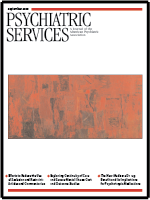Guidelines for Behavioral Emergencies
The current emphasis on psychiatric treatment in the least restrictive setting has led to a decrease in the number of inpatient psychiatric beds. The number of episodes of psychiatric care has more than doubled since 1970. In addition, payment for psychiatric management is frequently in proportion to a patient's "dangerousness" rather than to the severity of mental illness. The result of the three trends is a large number of episodes of psychiatric emergency care and a higher concentration of aggressive psychiatric patients in emergency settings (1).
The Expert Consensus Guidelines on behavioral emergencies that were published in 2001 (2) provided a needed starting point for standardization of treatment in this area—treatment that is based on empirical evidence. However, more data on strategies in use and their outcomes need to be gathered before a more definitive, evidence-based approach can be developed. One of the areas of study recommended by the expert panel is the influence of race, ethnicity, and culture. Our group attempted to shed some light on this area by assembling two additional expert panels from outside North America, one from Italy and one from countries of the former Soviet Union.
In order to maximize the value and comparability of our data, we attempted to follow the methods used by the North American expert panel. We used the same questionnaire (translated into Italian and Russian) and mailed it to recognized experts in emergency psychiatry. A comparison of the three different sets of consensus guidelines reveals some similarities, which help legitimize some aspects of the original guidelines.
Treatment approaches on which all panels agreed form a core of practices on which psychiatrists who manage behavioral emergencies can rely, because they are embraced (and therefore presumed effective) by three expert panels operating in very diverse settings. One of the strategies on which all three panels agreed unanimously was the preference for intravenous formulations of antipsychotics and benzodiazepines because of the rapidity of onset. They also agreed that the first choice among intramuscular formulations should be a second-generation antipsychotic, because of its superior efficacy and safety profile compared with first-generation antipsychotics and benzodiazepines.
However, some differences between the guidelines are thought provoking and may ultimately spark discussion that leads to more refined practice in this area of psychiatric care. In defining the short- and long-term goals of intervention in an acute crisis, the Italian and North American panels cited the control of aggressive behavior as the primary goal. However, the panel from the former Soviet Union countries felt that cooperation with the patient should be the primary goal of any intervention
More analysis is needed in the areas of disagreement to ascertain the reasons for these differences and to determine which strategy is indeed optimal in a given setting. Our hope is that these results will carry forward the impetus that began with the publication of the original North American guidelines in 2001 and that more administrators and clinicians will allocate the time and resources needed to further refine evidence-based protocols for managing behavioral emergencies. More information on the Italian and former Soviet Union panels is available at www.psyter.org.
Dr. Di Fiorino and Dr. Gemignani are affiliated with the department of psychiatry at Versilia General Hospital in Lido di Camaiore, Italy. Dr Danielyan is affiliated with the National Institute of Mental Health in Yerevan, Armenia.
1. Di Fiorino M, Danielyan A, Yevchuk S, et al: The clinical management of the aggressive patient in behavioural emergency: some differences between Italy, North America, and former Soviet Union. Bridging Eastern and Western Psychiatry 3:16–23,2005. Available at www.psyter.orgGoogle Scholar
2. Allen MH, Currier GW, Hughes DH, et al: The Expert Consensus Guideline Series: treatment of behavioral emergencies. Postgraduate Medicine 110(special no):1–88,2001Google Scholar



